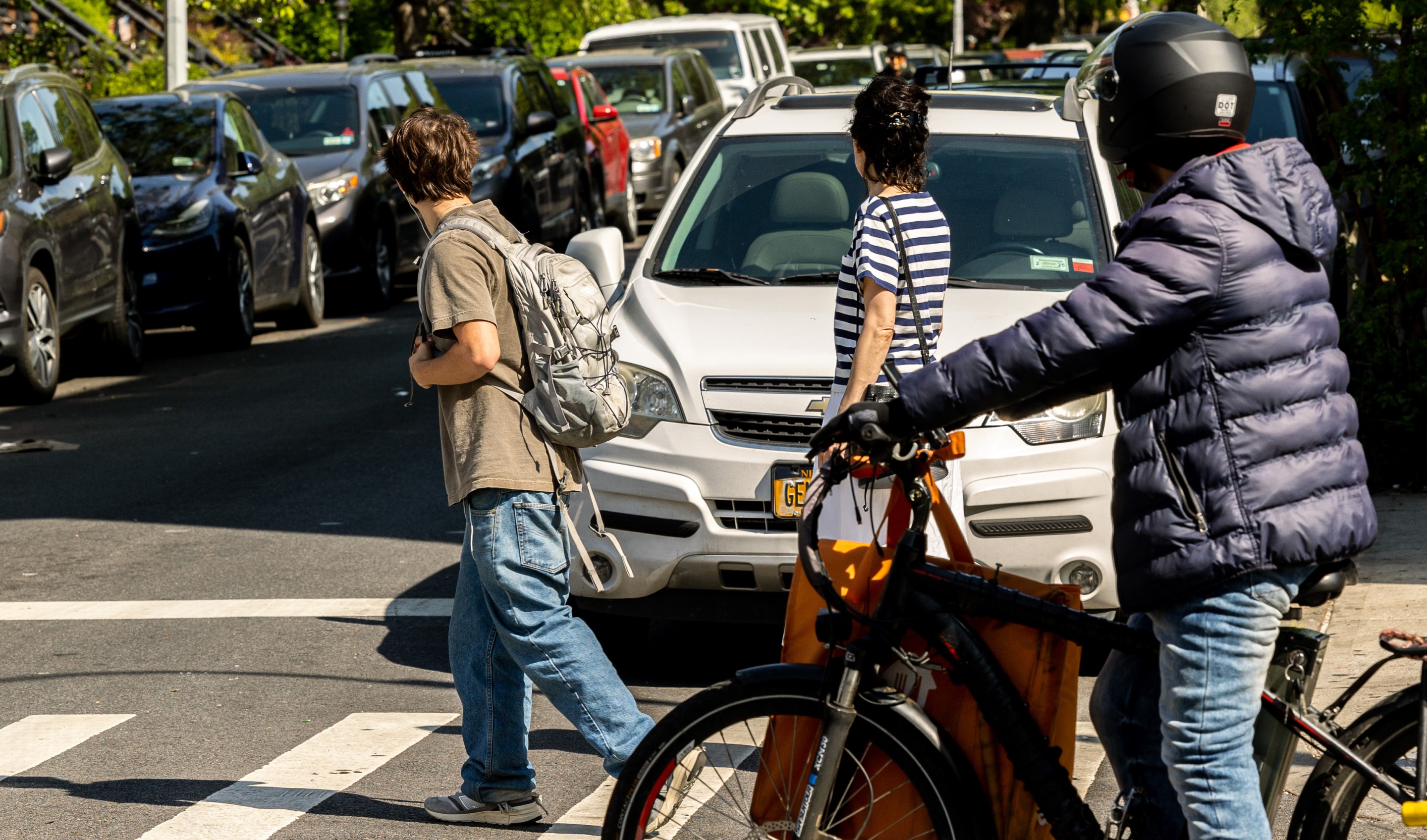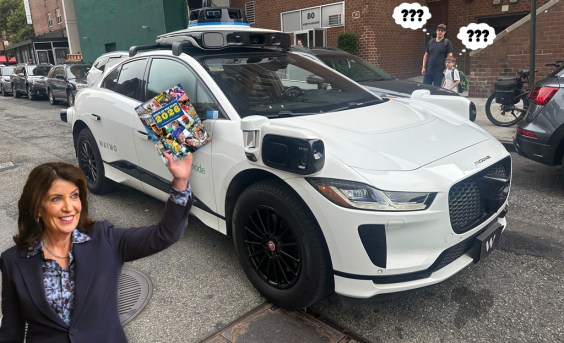After a deadly crash that killed a 7-year-old last year, Mayor Adams vowed to ban parking near 1,000 intersections annually to improve visibility — a road safety treatment also known as daylighting — but data indicate that the city is overstating its progress while installing ineffective measures to keep corners clear.
The Oct. 26, 2023, killing of Kamari Hughes by an NYPD tow truck driver at a poorly daylighted intersection in Fort Greene spurned City Hall to pledge to upgrade 2,000 intersections and add "lifesaving visibility improvements through a tool known as daylighting to at least 1,000 of those intersections each year."
But in early September, the Department of Transportation altered the language to say it would "add daylighting to 1,000 locations in 2024" [emphasis added]. In the same announcement, the agency released a list of 314 spots that had gotten the improvements since the mayor's vow. But the agency was actually counting multiple corners at some of the same intersections, not discrete intersections, since that list included 73 locations that DOT logged twice or three times, and at least a handful of locations that pre-date Adams's commitment.
The misleading counts wouldn't be the first time for Adams's DOT to overstate its achievements. In 2022 it claimed to have made safety improvements at more than 1,400 intersections. Many of the intersections listed were duplicates; the majority of changes involved retimed traffic lights or an additional stop sign — not physical street redesigns.
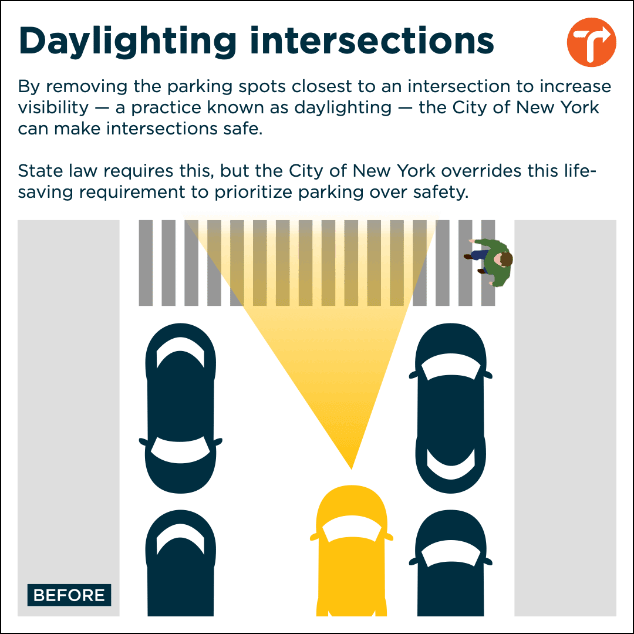
An agency spokesperson said the DOT was "working toward" completing the 1,000-intersection vow during the next two-plus months remaining in the year.
"Hundreds of intersections [are] already complete and the bulk of the work [is] slated for the coming weeks," said Vin Barone. "This initiative will represent a 230-percent increase in daylighting installations from last year, and includes a mix of treatments, including signage, as well as physically daylit locations with items like bike corrals, planters, and concrete blocks, which can help slow turning drivers while improving visibility."
Questionable numbers
To date, DOT has installed daylighting at 460 locations, covering nearly 400 distinct intersections, Barone told Streetsblog, but he declined to provide a list, including which treatments the agency implemented at each corner.
Advocates accused the Adams administration for trying to get credit for half-measures.
"Once again, Mayor Adams has overpromised and failed to deliver. When the mayor promises to daylight 1,000 intersections, New Yorkers expect him to do so. Instead of getting the job done, he's trying to take credit for half-measures that keep New Yorkers at risk by leaving intersections dangerous and blind," said Philip Miatkowski, Senior Director of Research & Policy at Transportation Alternatives.
"We know daylighting saves lives when done right. By failing to keep the promise he made, Mayor Adams is allowing more crashes, injuries, and deaths into neighborhoods across New York City," Miatkowski added.
Streetsblog spot-checked four locations in Brooklyn and Manhattan, two of which had some sort of physical infrastructure, but arguably on the least useful side of the intersection, while the other two just had "No Standing Anytime" signs.
Drivers largely ignored the new no parking signage, including, ironically, a car parked at the intersection of W. Ninth and Hicks streets in Red Hook with a school crossing guard's vest in the dash:
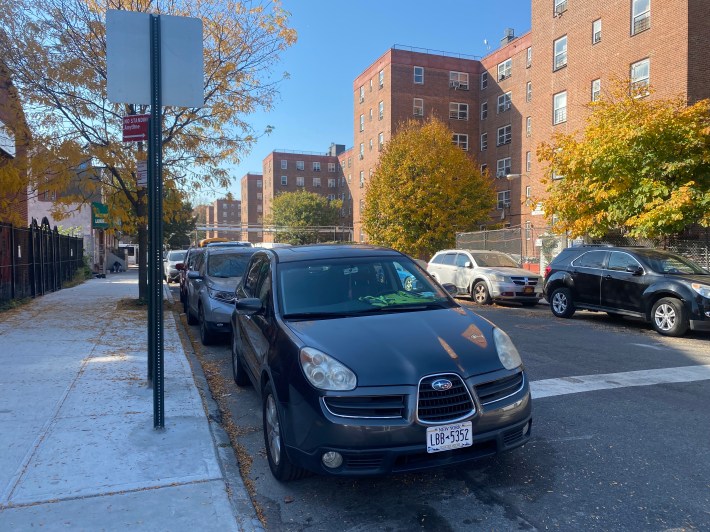
DOT counted the Red Hook junction twice on its list, but it was not clear which corners were part of its revamps.
The opposite side of the street had a yellow striped spot and even a sidewalk expansion with tables and chairs, but the improvements do not actually provide pedestrians with more visibility — because drivers on the one-way street come from the other side of the crosswalk.
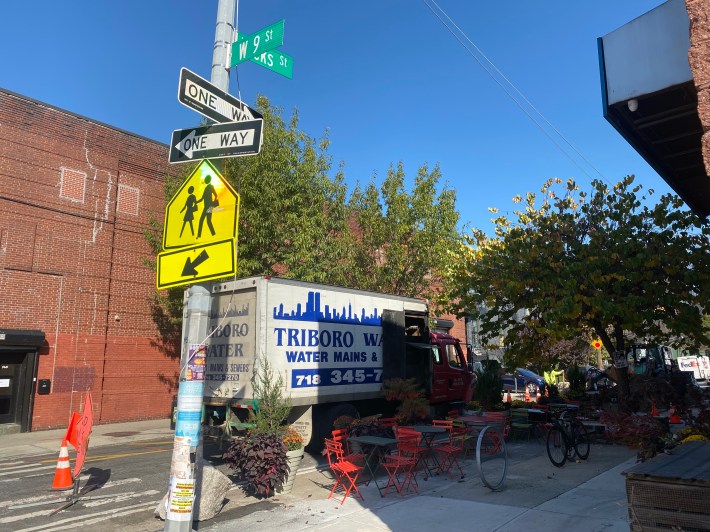
Similarly, in Williamsburg, at the corner of N. Fourth Street and Bedford Avenue, the city installed bike racks on one corner and a "No Standing" sign on the other, but both were in places that did not improve drivers' sight lines of the crosswalk.
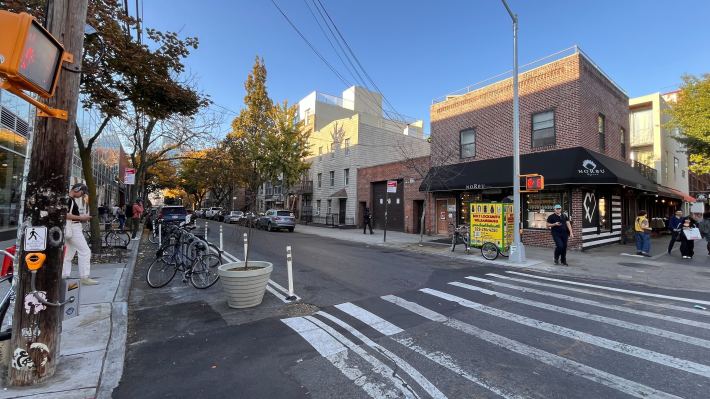
Meanwhile other corners at the same intersections retained corner parking where daylighting would have actually improved visibility for drivers, like here in Red Hook:
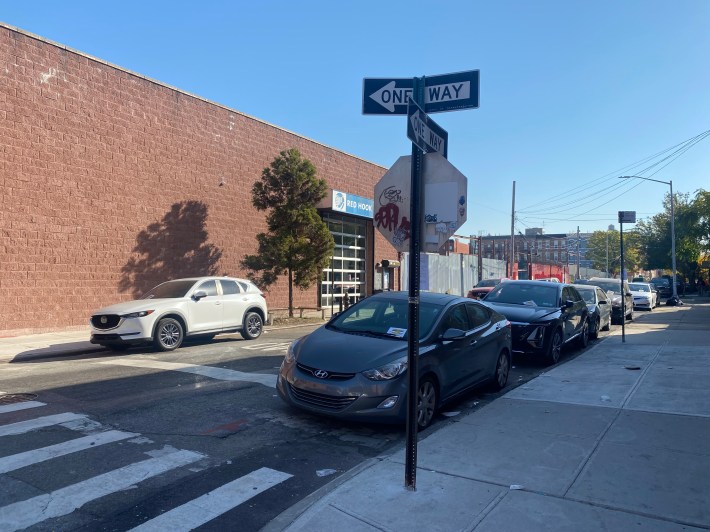
Another location at East Broadway and Montgomery Street on the Lower East Side also just had a "No Standing" sign at one corner, which, of course, was occupied by an illegally parked car.
That's where the city's signage program runs up against the reality that cops routinely don't enforce parking regulations, especially in areas around their own station houses and hotspots of parking placard abuse near government buildings.
"It comes down to, are they [DOT] working in tandem with their parking enforcement, is NYPD playing a role in this, are they committed to working on enforcement if there’s no infrastructure there," said Ryan Sharp, former transportation chief of Hoboken, New Jersey, which has become a daylighting model in the region.
Meanwhile, on Third Avenue and 19th Street in Sunset Park, the complicated intersection below the elevated Brooklyn-Queens Expressway had one No Standing sign at its north corner, but DOT counted that junction twice.
There were also two "No Standing" signs on the eastern side of Third Avenue, but those have been around for at least a decade, according to old Google Street View images.
DOT also listed several corners along Underhill Avenue in Prospect Heights which received their upgrades in 2023, not 2024, neighborhood local Alex Morano found.
Street safety boosters called on the city to stop fudging the numbers and get serious about making effective corner parking bans standard practice across the five boroughs.
"DOT itself has said that daylighting isn’t all that effective without protection, so it’s disappointing that every corner or intersection doesn’t have that," said Emily Chingay, an engagement advocate with Open Plans. "Maybe there’s hope that DOT can get to work and implement this daylighting goal in a way that actually matches the promise, without cutting corners or shortchanging all the New Yorkers who are eager for these street improvements."
Open Plans, which shares a parent organization with Streetsblog, has helped organize community boards and elected officials to endorse universal daylighting at every intersection in the city. Daylighting is already the law statewide, but the city is allowed to exempt itself from that provision.
For daylighting to work, experts said, the Big Apple needs more than just signs. Painted and concrete curb extensions, granite blocks and bike corrals — which DOT has implemented successfully on some corridors, such as the Berry Street bike boulevard — all guarantee corners clear of visually obstructive parked cars. Even a plastic flex post can be a quick and cheap tool to signal to drivers that this space is off limits, said Sharp.
"In any city that has really high on-street parking demand, such as New York, such as Hoboken, it’s way way way more effective — and I would argue even essential — to install some kind of physical infrastructure in those corner clear zones to keep cars from parking there," he said.
Institutionalizing daylighting
In contrast, over in Hoboken, where traffic officials aggressively rolled out daylighting over the past decade and successfully curbed traffic violence, planners added infrastructure every time a street was repaved or reconstructed, according to Sharp, who left the Mile Square City's government this year for the consulting firm Alta Planning and Design.
"We made a ton of progress doing it like that, because that’s one way to institutionalize the implementation of daylighting," he said.
Their daylighting happened on three levels of redesigns, depending on the funding available. The lowest-cost option was at least a flex post, but if they had more money, officials painted or built out curb extensions, or even added rain gardens that had the additional benefit of reducing flooding.
"We took a good, better, best approach to it," Sharp said. "For us the baseline was always vertical delineator posts, that was the most cost-effective, cheapest, we called that our good approach."
However, the plastic posts also add more maintenance, due to drivers running them over, and Hoboken had to replace about one in five every year, Sharp said.
Grassroots push
New York City's first systematic push for daylighting also followed a growing grassroots push by community boards and local politicians, who passed resolutions and signed letters calling for universal daylighting across the city's roughly 40,000 intersections.
The state already prohibits parking within 20 feet of crosswalks, but the city has long been allowed to exempt itself from that provision, opting for a cordon of car storage instead. That's despite 55 percent of pedestrian deaths and 79 percent of pedestrian traffic injuries happening at intersections, according to DOT.
There is a bill in the State Legislature to undo that carveout, and on the city level, Council Member Julie Won (D–Queens) is crafting mirroring legislation, though that is still in early stages, according to a spokesperson.
The civic push originated in the World's Borough in June 2023, when local Community Board 1 passed a resolution calling on the city implement widespread daylighting, following drivers killing two children at intersections, including 7-year-old Dolma Naadhun in Astoria.
Since then, 18 boards from all boroughs except Staten Island have passed similar measures, often unanimously, and 54 local politicians from all three levels of government have signed on to statements in support, according to advocates keeping track.
Sharp said that DOT's efforts were a good start at taking a broader approach to daylighting, but that the city should build out its efforts.
"There aren’t many places in the entire country that have committed to that, so it may seem like low-hanging fruit, but it’s a new thing," he said. "New York’s breaking through some very longstanding culture about how people park."
Additional reporting by Sophia Lebowitz
